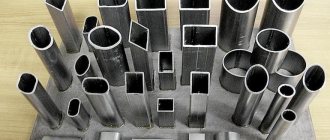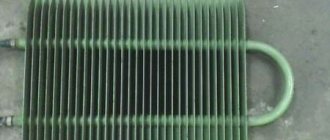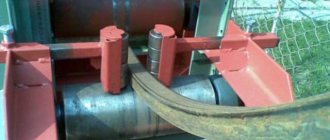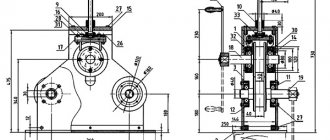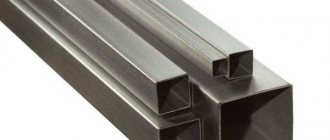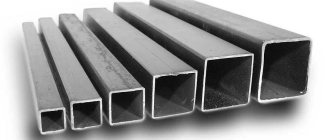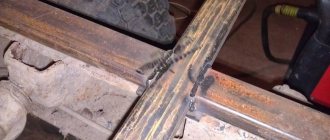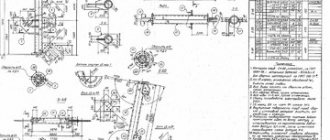A profile pipe is a metal product, its cross-section is square or rectangular. It has great mechanical strength, so it does not break under heavy loads. There is a large selection of sizes, which allows you to choose the material for many different purposes and tasks.
The product labeling contains all the information about them. For example, from the name Profile 160x100x5 GOST 30245-2003/S245 GOST 27772-88 you can get the following data:
- 160 – height (in mm);
- 100 – width (in mm);
- 5 – thickness (in mm);
- GOST 30245-2003 – profile compliance with the standard;
- C245 – steel grade (in this particular case – unalloyed low-carbon steel);
- GOST 27772-88 – corresponds to the steel standard.
The main area of use of steel profile pipes is construction. The material is used to create different types of structures of varying complexity. Often, square pipe GOST 30245-2003 is used for the construction of frames. The breadth of use of these products in construction work is due to their affordable price, ease of use, the ability to quickly perform a large amount of work, and excellent performance characteristics.
| Table of main characteristics of profile pipe | |||
| Drawing | Dimensions (H), mm | Weight, kg | Standard |
| Square pipe | from 10 to 180 | from 0.269 to 70.33 | GOST 8639-82 |
| Rectangular pipe | from 10 to 180 | from 0.348 to 55.71 | GOST 8645-68 |
Standard sizes and their meaning
The price of profile products exceeds the cost of standard ones, since first craftsmen make standard pipes with round sections, and then convert them into other shapes. The cost is calculated on a per linear meter basis; accordingly, the greater the weight, the higher the price. When developing a project, profile pipes are of particular importance to engineers. Their size and weight directly affect the strength of the building. They are used in furniture frames, residential buildings, and commercial prefabricated buildings, so a mistake can cause a fatal collapse. Most often, frame products are made from steel and aluminum. Due to their higher density, steel pipes are always heavier, but aluminum profile pipes are easier to adjust to the dimensions of the planned structures. To calculate the weight of an individual product, several components are important:
- Width, length and wall thickness;
- Density of different types of steel, aluminum alloys;
- Weight proportional to the dimensions of the product (values are in GOST reference books).
Using the example of a design layout, the engineer calculates the load for each of its fragments and selects appropriately sized profile pipes. It is easiest to make calculations for square and rectangular sections, and for oval sizes it is important to take into account the roundness of the corners. The special GOST marking is a great help.
Profiled pipe weight
For a profile pipe, the size table is important, but the table with the weight of the products is no less important. It indicates the weight of 1 meter for a pipe with certain characteristics (height, width and thickness).
| Table of dimensions and weight of profile square pipe | |||
| Dimensions, mm | Wall thickness, mm | Weight 1m, kg | Meters in 1 ton |
| Square pipe 10x10 | 1,0 | 0,269 | 3717,5 |
| Square pipe 15x15 | 1,0 | 0,426 | 2347,4 |
| 1,5 | 0,605 | 1652,9 | |
| Square pipe 20x20 | 1,0 | 0,583 | 1715,3 |
| 1,5 | 0,841 | 1189,1 | |
| 2,0 | 1,075 | 930,2 | |
| Square pipe 25x25 | 1,0 | 0,740 | 1351,4 |
| 1,5 | 1,070 | 934,6 | |
| 2,0 | 1,390 | 719,4 | |
| 2,5 | 1,680 | 595,2 | |
| 3,0 | 1,950 | 512,8 | |
| Square pipe 30x30 | 2,0 | 1,700 | 588,2 |
| 2,5 | 2,070 | 483,1 | |
| 3,0 | 2,420 | 413,2 | |
| 3,5 | 2,750 | 363,6 | |
| 4,0 | 3,040 | 328,9 | |
| Square pipe 35x35 | 2,0 | 2,020 | 495.0 |
| 2,5 | 2,460 | 406,5 | |
| 3,0 | 2,890 | 346,0 | |
| 3,5 | 3,300 | 303,0 | |
| 4,0 | 3,670 | 272,5 | |
| 5,0 | 4,370 | 228,8 | |
| Square pipe 40x40 | 2,0 | 2,330 | 429.2 |
| 2,5 | 2,850 | 350,9 | |
| 3,0 | 3,360 | 297,6 | |
| 3,5 | 3,850 | 259,7 | |
| 4,0 | 4,300 | 232,6 | |
| 5,0 | 5,160 | 193,8 | |
| 6,0 | 5,920 | 168,9 | |
| Square pipe 42x42 | 3,0 | 3,550 | 281,7 |
| 3,5 | 4,070 | 245,7 | |
| 4,0 | 4,560 | 219,3 | |
| 5,0 | 5,470 | 182,8 | |
| 6,0 | 6,300 | 158,7 | |
| Square pipe 45x45 | 3,0 | 3,830 | 261,1 |
| 3,5 | 4,400 | 227,3 | |
| 4,0 | 4,930 | 202,8 | |
| 5,0 | 5,940 | 168,4 | |
| 6,0 | 6,860 | 145,8 | |
| 7,0 | 7,690 | 130,0 | |
| 8,0 | 8,430 | 118,6 | |
| Square pipe 50x50 | 3,0 | 4,310 | 232,0 |
| 3,5 | 4,940 | 202,4 | |
| 4,0 | 5,560 | 179,9 | |
| 5,0 | 6,730 | 148,6 | |
| 6,0 | 7,800 | 128,2 | |
| 7,0 | 8,790 | 113,8 | |
| 8,0 | 9,690 | 103,2 | |
| Square pipe 60x60 | 3,5 | 6,040 | 165,6 |
| 4,0 | 6,820 | 146,6 | |
| 5,0 | 8,300 | 120,5 | |
| 6,0 | 9,690 | 103,2 | |
| 7,0 | 11,000 | 90,9 | |
| 8,0 | 12,200 | 82,0 | |
| Square pipe 70x70 | 4,0 | 8,070 | 123,9 |
| 5,0 | 9,870 | 101,3 | |
| 6,0 | 11,570 | 86,4 | |
| 7,0 | 13,190 | 75,8 | |
| 8,0 | 14,710 | 68,0 | |
| Square pipe 80x80 | 4,0 | 9,330 | 107,2 |
| 5,0 | 11,440 | 87,4 | |
| 6,0 | 13,460 | 74,3 | |
| 7,0 | 15,380 | 65,0 | |
| 8,0 | 17,220 | 58,1 | |
| Square pipe 90x90 | 5,0 | 13,000 | 76,9 |
| 6,0 | 15,340 | 65,2 | |
| 7,0 | 17,580 | 56,9 | |
| 8,0 | 19,730 | 50,7 | |
| Square pipe 100x100 | 6,0 | 17,220 | 58,1 |
| 7,0 | 19,780 | 50,6 | |
| 8,0 | 22,250 | 44,9 | |
| 9,0 | 24,620 | 40,6 | |
| Square pipe 110x110 | 6,0 | 19,110 | 52,3 |
| 7,0 | 21,980 | 45,5 | |
| 8,0 | 24,760 | 40,4 | |
| 9,0 | 27,450 | 36,4 | |
| Square pipe 120x120 | 6,0 | 20,990 | 47,6 |
| 7,0 | 24,180 | 41,4 | |
| 8,0 | 27,270 | 36,7 | |
| 9,0 | 30,280 | 33,0 | |
| Square pipe 140x140 | 6,0 | 24,760 | 40,4 |
| 7,0 | 28,570 | 35,0 | |
| 8,0 | 32,290 | 31,0 | |
| 9,0 | 35,930 | 27,8 | |
| Square pipe 150x150 | 7,0 | 30,770 | 32,5 |
| 8,0 | 34,810 | 28,7 | |
| 9,0 | 38,750 | 25,8 | |
| 10,0 | 42,610 | 23,5 | |
| Square pipe 180x180 | 8,0 | 42,340 | 23,6 |
| 9,0 | 47,230 | 21,2 | |
| 10,0 | 52,030 | 19,2 | |
| 12,0 | 61,360 | 16,3 | |
| 14,0 | 70,330 | 14,2 | |
| Table of dimensions and weight of profile rectangular pipe | |||
| Dimensions, mm | Wall thickness, mm | Weight 1m, kg | Meters in 1 ton |
| Rectangular pipe 15x10 | 1,0 | 0,348 | 2873,6 |
| 1,5 | 0,488 | 2049,2 | |
| 2,0 | 0,605 | 1652,9 | |
| Rectangular pipe 20x10 | 1,0 | 0,426 | 2347,4 |
| 1,5 | 0,605 | 1652,9 | |
| 2,0 | 0,762 | 1312,3 | |
| Rectangular pipe 20x15 | 1,0 | 0,505 | 1980,2 |
| 1,5 | 0,723 | 1383,1 | |
| 2,0 | 0,919 | 1088,1 | |
| 2,5 | 1,090 | 917,4 | |
| Rectangular pipe 25x10 | 1,0 | 0,505 | 1980,2 |
| 1,5 | 0,723 | 1383,1 | |
| 2,0 | 0,919 | 1088,1 | |
| 2,5 | 1,090 | 917,4 | |
| Rectangular pipe 25x15 | 1,0 | 0,583 | 1715,3 |
| 1,5 | 0,841 | 1189,1 | |
| 2,0 | 1,080 | 925,9 | |
| 2,5 | 1,290 | 775,2 | |
| Rectangular pipe 30x10 | 1,0 | 0,583 | 1715,3 |
| 1,5 | 0,841 | 1189,1 | |
| 2,0 | 1,080 | 925,9 | |
| 2,5 | 1,290 | 775,2 | |
| 3,0 | 1,480 | 675,7 | |
| Rectangular pipe 30x15 | 1,0 | 0,661 | 1512,9 |
| 1,5 | 0,959 | 1042,8 | |
| 2,0 | 1,230 | 813,0 | |
| 2,5 | 1,480 | 675,7 | |
| 3,0 | 1,710 | 584,8 | |
| Rectangular pipe 30x20 | 1,0 | 0,740 | 1351,4 |
| 1,5 | 1,080 | 925,9 | |
| 2,0 | 1,390 | 719,4 | |
| 2,5 | 1,680 | 595,2 | |
| 3,0 | 1,950 | 512,8 | |
| Rectangular pipe 35x15 | 1,5 | 1,080 | 925,9 |
| 2,0 | 1,390 | 719,4 | |
| 2,5 | 1,680 | 595,2 | |
| 3,0 | 1,950 | 572,8 | |
| 3,5 | 2,200 | 454,5 | |
| Rectangular pipe 35x20 | 1,5 | 1,190 | 840,3 |
| 2,0 | 1,550 | 645,2 | |
| 2,5 | 1,880 | 531,9 | |
| 3,0 | 2,190 | 456,6 | |
| 3,5 | 2,470 | 404,9 | |
| Rectangular pipe 35x25 | 1,5 | 1,310 | 763,4 |
| 2,0 | 1,700 | 588,2 | |
| 2,5 | 2,070 | 483,1 | |
| 3,0 | 2,420 | 413,2 | |
| 3,5 | 2,750 | 363,6 | |
| Rectangular pipe 40x15 | 2,0 | 1,550 | 645,2 |
| 2,5 | 1,880 | 531,9 | |
| 3,0 | 2,190 | 456,6 | |
| 3,5 | 2,470 | 404,9 | |
| 4,0 | 2,730 | 336,3 | |
| Rectangular pipe 40x20 | 2,0 | 1,700 | 588,2 |
| 2,5 | 2,070 | 483,1 | |
| 3,0 | 2,420 | 413,2 | |
| 3,5 | 2,750 | 363,6 | |
| 4,0 | 3,050 | 327,9 | |
| Rectangular pipe 40x25 | 2,0 | 1,860 | 537,6 |
| 2,5 | 2,270 | 440,5 | |
| 3,0 | 2,660 | 375,9 | |
| 3,5 | 3,020 | 331,1 | |
| 4,0 | 3,360 | 297,6 | |
| Rectangular pipe 40x30 | 2,0 | 2,020 | 495,0 |
| 2,5 | 2,470 | 404,9 | |
| 3,0 | 2,890 | 346,0 | |
| 3,5 | 3,300 | 303,0 | |
| 4,0 | 3,680 | 271,7 | |
| Rectangular pipe (42)x20 | 2,0 | 1,770 | 565,0 |
| 2,5 | 2,150 | 465,1 | |
| 3,0 | 2,520 | 396,8 | |
| 3,5 | 2,860 | 349,6 | |
| 4,0 | 3,170 | 315,4 | |
| Rectangular pipe 45x20 | 2,0 | 1,860 | 537,6 |
| 2,5 | 2,270 | 440,5 | |
| 3,0 | 2,660 | 375,9 | |
| 3,5 | 3,020 | 331,1 | |
| 4,0 | 3,360 | 297,6 | |
| Rectangular pipe 45x30 | 2,0 | 2,170 | 460,8 |
| 2,5 | 2,660 | 375,9 | |
| 3,0 | 3,130 | 319,5 | |
| 3,5 | 3,570 | 280,1 | |
| 4,0 | 3,990 | 250,6 | |
| Rectangular pipe 50x25 | 2,0 | 2,170 | 460,8 |
| 2,5 | 2,660 | 375,9 | |
| 3,0 | 3,130 | 319,5 | |
| 3,5 | 3,570 | 280,1 | |
| 4,0 | 3,990 | 250,6 | |
| Rectangular pipe 50x30 | 2,0 | 2,320 | 431,0 |
| 2,5 | 2,860 | 349,6 | |
| 3,0 | 3,360 | 297,6 | |
| 3,5 | 3,850 | 259,7 | |
| 4,0 | 4,300 | 232,5 | |
| Rectangular pipe 50x35 | 2,0 | 2,490 | 401,6 |
| 2,5 | 3,090 | 323,6 | |
| 3,0 | 3,600 | 277,8 | |
| 3,5 | 4,120 | 242,7 | |
| 4,0 | 4,620 | 216,4 | |
| Rectangular pipe 50x40 | 2,0 | 2,650 | 377,3 |
| 2,5 | 3,250 | 307,7 | |
| 3,0 | 3,830 | 261,0 | |
| 3,5 | 4,390 | 227,8 | |
| 4,0 | 4,930 | 202,8 | |
| Rectangular pipe 60x25 | 2,5 | 3,050 | 327,9 |
| 3,0 | 3,600 | 277,8 | |
| 3,5 | 4,120 | 242,7 | |
| 4,0 | 4,620 | 216,4 | |
| 5,0 | 5,550 | 180,1 | |
| Rectangular pipe 60x30 | 2,5 | 3,250 | 307,7 |
| 3,0 | 3,830 | 261,0 | |
| 3,5 | 4,390 | 227,8 | |
| 4,0 | 4,930 | 202,8 | |
| 5,0 | 5,940 | 168,3 | |
| Rectangular pipe 60x40 | 3,0 | 4,300 | 232,5 |
| 3,5 | 4,940 | 202,4 | |
| 4,0 | 5,560 | 179,9 | |
| 5,0 | 6,730 | 148,6 | |
| Rectangular pipe 70x30 | 3,0 | 4,300 | 232,5 |
| 3,5 | 4,940 | 202,4 | |
| 4,0 | 5,560 | 179,9 | |
| 5,0 | 6,730 | 148,6 | |
| 6,0 | 7,800 | 128,2 | |
| Rectangular pipe 70x40 | 3,0 | 4,780 | 209,2 |
| 3,5 | 5,490 | 182,1 | |
| 4,0 | 6,190 | 161,6 | |
| 5,0 | 7,510 | 133,1 | |
| 6,0 | 8,750 | 114,2 | |
| Rectangular pipe 70x50 | 3,0 | 5,250 | 190,5 |
| 3,5 | 6,040 | 165,6 | |
| 4,0 | 6,820 | 146,6 | |
| 5,0 | 8,300 | 120,5 | |
| 6,0 | 9,690 | 103,2 | |
| Rectangular pipe 80x40 | 3,0 | 5,250 | 190,5 |
| 3,5 | 6,040 | 165,6 | |
| 4,0 | 6,820 | 146,6 | |
| 5,0 | 8,300 | 120,5 | |
| 6,0 | 9,690 | 103,1 | |
| 7,0 | 10,990 | 91,0 | |
| Rectangular pipe 80x50 | 3,0 | 5,720 | 174,8 |
| 3,5 | 6,590 | 151,7 | |
| 4,0 | 7,440 | 134,4 | |
| Rectangular pipe 80x60 | 3,5 | 7,140 | 140,0 |
| 4,0 | 8,070 | 123,9 | |
| 5,0 | 9,870 | 101,3 | |
| 6,0 | 11,570 | 86,4 | |
| 7,0 | 13,190 | 75,8 | |
| Rectangular pipe 90x40 | 3,5 | 6,590 | 151,7 |
| 4,0 | 7,440 | 134,4 | |
| 5,0 | 9,080 | 110,1 | |
| 6,0 | 10,630 | 94,1 | |
| 7,0 | 12,090 | 82,7 | |
| Rectangular pipe 90x60 | 4,0 | 8,700 | 114,9 |
| 5,0 | 10,650 | 93,9 | |
| 6,0 | 12,510 | 79,9 | |
| 7,0 | 14,290 | 70,0 | |
| Rectangular pipe 100x40 | 4,0 | 8,070 | 123,9 |
| 5,0 | 9,870 | 101,3 | |
| 6,0 | 11,570 | 86,4 | |
| 7,0 | 13,190 | 75,8 | |
| Rectangular pipe 100x50 | 4,0 | 8,700 | 114,9 |
| 5,0 | 10,650 | 93,9 | |
| 6,0 | 12,510 | 79,9 | |
| 7,0 | 14,290 | 70,0 | |
| Rectangular pipe 100x70 | 4,0 | 9,960 | 100,4 |
| 5,0 | 12,220 | 81,8 | |
| 6,0 | 14,400 | 69,4 | |
| 7,0 | 16,480 | 60,7 | |
| Rectangular pipe 110x40 | 4,0 | 8,700 | 114,9 |
| 5,0 | 10,650 | 93,9 | |
| 6,0 | 12,510 | 79,9 | |
| 7,0 | 14,290 | 70,0 | |
| Rectangular pipe 110x50 | 4,0 | 9,330 | 107,1 |
| 5,0 | 11,440 | 87,4 | |
| 6,0 | 13,460 | 74,3 | |
| 7,0 | 15,380 | 65,0 | |
| Rectangular pipe 110x60 | 4,0 | 9,960 | 100,4 |
| 5,0 | 12,220 | 81,8 | |
| 6,0 | 14,400 | 69,4 | |
| 7,0 | 16,480 | 60,7 | |
| Rectangular pipe 120x40 | 5,0 | 11,440 | 87,4 |
| 6,0 | 13,460 | 74,3 | |
| 7,0 | 15,380 | 65,0 | |
| 8,0 | 17,220 | 58,1 | |
| Rectangular pipe 120x60 | 5,0 | 13,000 | 76,9 |
| 6,0 | 15,340 | 65,2 | |
| 7,0 | 17,580 | 56,9 | |
| 8,0 | 19,730 | 50,7 | |
| Rectangular pipe 120x80 | 5,0 | 14,580 | 68,6 |
| 6,0 | 17,220 | 58,0 | |
| 7,0 | 19,780 | 50,5 | |
| 8,0 | 22,250 | 45,0 | |
| Rectangular pipe 140x60 | 5,0 | 14,580 | 68,6 |
| 6,0 | 17,220 | 58,0 | |
| 7,0 | 19,780 | 50,5 | |
| 8,0 | 22,250 | 44,9 | |
| Rectangular pipe 140x80 | 5,0 | 16,150 | 61,9 |
| 6,0 | 19,110 | 52,3 | |
| 7,0 | 21,980 | 45,5 | |
| 8,0 | 24,760 | 40,3 | |
| Rectangular pipe 140x120 | 6,0 | 22,880 | 43,7 |
| 7,0 | 26,370 | 37,9 | |
| 8,0 | 29,780 | 33,6 | |
| 9,0 | 33,100 | 30,2 | |
| Rectangular pipe 150x80 | 6,0 | 20,050 | 49,9 |
| 7,0 | 23,080 | 43,3 | |
| 8,0 | 26,010 | 38,4 | |
| 9,0 | 28,860 | 34,6 | |
| 10,0 | 31,620 | 31,6 | |
| Rectangular pipe 150x100 | 6,0 | 21,930 | 45,6 |
| 7,0 | 25,280 | 39,6 | |
| 8,0 | 28,530 | 35,0 | |
| 9,0 | 31,690 | 31,6 | |
| 10,0 | 34,760 | 28,8 | |
| Rectangular pipe 180x80 | 7,0 | 26,370 | 37,9 |
| 8,0 | 29,780 | 33,6 | |
| 9,0 | 33,100 | 30,2 | |
| 10,0 | 36,330 | 27,5 | |
| 12,0 | 42,520 | 23,5 | |
| Rectangular pipe 180x100 | 8,0 | 32,290 | 31,0 |
| 9,0 | 35,930 | 27,8 | |
| 10,0 | 39,470 | 25,3 | |
| 12,0 | 46,290 | 21,6 | |
| Rectangular pipe 180x150 | 8,0 | 38,570 | 25,9 |
| 9,0 | 42,990 | 23,3 | |
| 10,0 | 47,320 | 21,1 | |
| 12,0 | 55,710 | 17,9 | |
The weight of a linear meter can range from 0.478 to 9.01 kg. For example, a pipe with dimensions 15x15x1.2 will have a weight of 0.5 kg. The weight is approximate; slight deviations from the norm are possible in accordance with the tolerances specified in the relevant standards. Weight is important when choosing a product. The greater the mass, the higher the strength and ability to withstand a certain level of constant loads. The easiest way to find out the weight of the profile pipe is from the table above.
Maximum deviations in height and width of the profile must correspond to:
- with profile height (width) up to 100 mm ... ±1.0, but not less
- with a profile height (width) over 100 mm ... ± 0.8.
Types of markings
It is difficult for a simple buyer of building materials to calculate the necessary parameters for calculating weight. This requires detailed data, which cannot always be obtained without special equipment:
- Length, width and wall thickness;
- Exact metal composition.
There is information that will make the weight calculation process easier. These are two things - special markings and types of profile pipes. The parameters are indicated inside the product, separated by an “x” icon, according to the following principle:
- Height;
- Width;
- Thickness;
- GOST number (often repeated with a special code).
For example, the designation 20x20x2 and GOST number C-245 indicates that the profile has a square cross-section, both walls are 20 mm, with a thickness of 2 mm, and is made of steel approved by the building code for the construction of durable frames. The length is not always indicated, but usually does not exceed the range of 6-12 m. Sometimes this is indicated at the end of the main marking.
Square profiles
Rolling metal factories prefer to sell products in bulk, without weighing each product individually. The customer’s task is to correctly calculate the mass of the total length of the products. Depending on the type of section, several groups of non-standard rolled metal can be distinguished:
- Oval and square;
- Diamond-shaped and rectangular;
- Square and trapezoidal.
There are special formulas for each option, and you can also use an online calculator and tables, which are often posted directly on the manufacturer’s website. To determine the weight of a square pipe, you need a formula using a constant (0.0157) and the parameters of volume (t), length of the segment (A) and metal density (p):
m = () x 0.0157 x t x (A x 2 – 2.86 x t) x L
The total mass of the batch, in this case, is calculated by multiplying the result obtained by the number of required products.
Oval sections
Profiles with an oval cross-section are produced by flattening round blanks. Stainless chrome-plated steel is optimal for them. They are used in decorative and frame structures, cooling systems, since the oval shape allows heat to be transferred faster than the round counterpart, while the surface area is larger. The equations used to calculate the masses of square and rectangular profiles are not suitable for calculating the weight of a linear meter of a profile pipe with an oval cross-section, since they do not take into account the diameter and rounded corners. The most reliable way is to use a calculator or lookup tables, but if this is not possible, but you need to find out the weight, then you can do this using a universal formula, suitable not only for oval, but also for profiles of more complex shapes:
m = (metal density) x S (diameter) x L (segment length).
Features of rectangular profile pipes
The “classic” round pipe will not be suitable in all conditions. For example, such a product bends more easily, which can negatively affect the strength of hanging structures and frames.
Rectangular corrugated pipes are highly decorative, so they are often used in the design of buildings, the creation of furniture and fencing. In addition, the large surface of the outer area of the pipe with a significant reduction in the internal space makes it possible to effectively use rectangular pipes in the construction of frames. Such products cope well with lateral loads, which is why they are used in the construction of load-bearing systems. Closed profiles are often used to construct building frames, columns, racks and floor beams. They are also used for reinforcing metal-plastic windows, assembling openings and door leaves.
Rectangular pipes
Instead of light aluminum ones, steel pipes with a rectangular cross-section are used as spacers in frames of any type and floors of houses. The formula used to calculate the mass of square profiles is not suitable for rectangular ones, since the sides of the section are not equal in length. There are two options - use a sample calculation yourself or fill out a special section of the calculator. The general equation for rectangular profiles is:
m = ((material density) / 7850) x 0.0157 x t (wall thickness) x (A (1 side of the rectangle) + B (2 side of the section) – 2.86 x t) x L (length of the segment).
It is preferable to use a calculator, since it can also calculate the deflection and bending of the profile and determine the total mass according to 5-6 schemes (with uniform and concentrated power load) and according to two GOST options. The maximum amount of deflection and bending can be entered independently, as well as other clarifying details. The calculation result in this case will be more accurate than using a general equation.
Product advantages
The main advantage of rectangular profile pipes is their significant spatial rigidity compared to products with a round cross-section. For example, if such a corrugated pipe is used as a load-bearing beam and the load is at an angle of 90 degrees to any plane, the bending resistance of the profile will be approximately 35% greater than that of other products. This indicator is close to the characteristics of a solid steel rod.
Due to their flat surfaces, rectangular products are easier to process. Painting and priming them is much easier, and protective coatings adhere better to such surfaces. Unlike a channel or an I-beam, such products do not have hard-to-reach places for processing. This improves corrosion resistance.
Also, the flat edges of rectangular corrugated pipes provide good ergonomics. The profiles are firmly connected to any structural elements. They are convenient to install on load-bearing surfaces. Also, such products take up minimal space and do not create dead zones at the base.
The presence of planes guarantees high resistance during storage and transportation.
Permissible errors and deviations
Any calculation method - using a formula, tables or calculator - gives a small percentage of error. The use of a constant indicator of the density of materials in calculations is conditional, since different alloys and types of steel are not the same in weight. The final indicator differs from the actual one, but when using a calculator this deviation is minimal, because the program is designed to enter the maximum possible number of parameters. To completely eliminate errors and omissions, it is necessary to check the parameters of the parts with the tables of GOST 30245-2003, where the standards and permissible errors are recorded:
- The length of the product and the cross-sectional area of the profile must coincide with the digital indicators in the tables, although a cross-sectional error of 1.5 - 2 degrees and 2 mm in length is allowed;
- The maximum deviation of a pipe 15 cm wide is 1 mm per linear meter;
- Deviation from a right angle of more than 1.5 mm is unacceptable;
- The classic length of 6-12 meters can be changed at the request of customers into segments of 3-4 meters;
- The wall thickness of the batch must match that of the control sample 15 cm long.
If the specified data and numerical indicators in the tables are exceeded, the strength of building structures may be at risk.
What is the best way to transport corrugated pipe from the metal depot to your site?
Having found out the weight and size of a square pipe, you will have to think about how to transport a profile of this size. Of course, everything depends on the total number and dimensions of pipes.
Different modes of transport can accommodate different profiles. Let's figure out how you can transport pipes of one size or another.
8-12 meters
To transport profile pipes of this size, you will need a long vehicle with a total side length of 13.5 m. This range is the heaviest and at the same time the most capacious cargo carrier. The entry of such transport into many cities is prohibited, so the transportation route should be thought out in advance, and if possible, hire another transport and purchase a profile of shorter length.
6 meters (the most common option)
Most often, metal warehouses offer profile pipes 6 meters long; they are easier to transport, they have less weight, and most importantly, they meet the needs of most clients. If you need to transport 1-4 such profiles, then you can use an ordinary gazelle as a carrier - expensive and angry, not every driver will agree to such an undertaking, because the installation of the cargo will be “with a twist.”
You can hire a Chinese light truck - their body is elongated and is up to 5 meters long.
If there are more than 4 profile pipes, then it is better to hire a Kamaz or a truck - they will deliver the cargo safely and securely, and most importantly, there will be no problems on the way to the site.
3 meters
A three-meter profile can be taken away in almost any car, but according to the Administrative Code, it is best, of course, to carry out this procedure using a gazelle. You can fit several dozen products of this length in it.
In any case, it is better not to take risks and hire a car with a body longer than the dimensions of the profile products that you decide to transport, this way you will protect the driver from fines, and yourself from unnecessary hassle when delivering building materials.
( 3 ratings, average: 5.00 out of 5)
Pipe weight calculator
When ordering a large batch of products, the easiest and fastest way is to use a pipe weight calculator. By calculating the weight of 1 meter of rolled metal on it, you can find out as accurately as possible the total mass of the entire batch, regardless of the complexity of the section - a simple square or a complex polygon. First you need to find out detailed information about the features of the profiles, including alloy composition and possible deviations from GOST, and enter them into the grid cells. A standard calculation will require knowledge of the following nuances:
- Conditional, nominal and outer diameter;
- Width, height and thickness of the product;
- Maximum permissible deflections and loads;
- Span length;
- Distance between supports and load application points;
- Size and number of pipes;
- Brand and main composition of the metal.
Correct and detailed filling of the cells guarantees the accuracy of the result, regardless of the dimensions of the product, which is a guarantee of the safety of the building as a whole.
